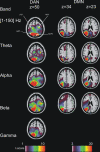Temporal dynamics of spontaneous MEG activity in brain networks
- PMID: 20304792
- PMCID: PMC2851876
- DOI: 10.1073/pnas.0913863107
Temporal dynamics of spontaneous MEG activity in brain networks
Abstract
Functional MRI (fMRI) studies have shown that low-frequency (<0.1 Hz) spontaneous fluctuations of the blood oxygenation level dependent (BOLD) signal during restful wakefulness are coherent within distributed large-scale cortical and subcortical networks (resting state networks, RSNs). The neuronal mechanisms underlying RSNs remain poorly understood. Here, we describe magnetoencephalographic correspondents of two well-characterized RSNs: the dorsal attention and the default mode networks. Seed-based correlation mapping was performed using time-dependent MEG power reconstructed at each voxel within the brain. The topography of RSNs computed on the basis of extended (5 min) epochs was similar to that observed with fMRI but confined to the same hemisphere as the seed region. Analyses taking into account the nonstationarity of MEG activity showed transient formation of more complete RSNs, including nodes in the contralateral hemisphere. Spectral analysis indicated that RSNs manifest in MEG as synchronous modulation of band-limited power primarily within the theta, alpha, and beta bands-that is, in frequencies slower than those associated with the local electrophysiological correlates of event-related BOLD responses.
Conflict of interest statement
The authors declare no conflict of interest.
Figures



 (Eq. 3;
(Eq. 3;  ) evaluated at time increments of 0.2 s. (C) Power spectral densities (PSD) of wide-band power (Eq. 2) in DAN and DMN nodes averaged across sessions and subjects. (D) Total interdependence measure (
) evaluated at time increments of 0.2 s. (C) Power spectral densities (PSD) of wide-band power (Eq. 2) in DAN and DMN nodes averaged across sessions and subjects. (D) Total interdependence measure (
Similar articles
-
Frequency specific interactions of MEG resting state activity within and across brain networks as revealed by the multivariate interaction measure.Neuroimage. 2013 Oct 1;79:172-83. doi: 10.1016/j.neuroimage.2013.04.062. Epub 2013 Apr 28. Neuroimage. 2013. PMID: 23631996 Free PMC article.
-
Spectral characteristics of resting state networks.Prog Brain Res. 2011;193:259-76. doi: 10.1016/B978-0-444-53839-0.00017-X. Prog Brain Res. 2011. PMID: 21854968
-
Deriving frequency-dependent spatial patterns in MEG-derived resting state sensorimotor network: A novel multiband ICA technique.Hum Brain Mapp. 2017 Feb;38(2):779-791. doi: 10.1002/hbm.23417. Epub 2016 Oct 22. Hum Brain Mapp. 2017. PMID: 27770478 Free PMC article.
-
How networks communicate: propagation patterns in spontaneous brain activity.Philos Trans R Soc Lond B Biol Sci. 2016 Oct 5;371(1705):20150546. doi: 10.1098/rstb.2015.0546. Philos Trans R Soc Lond B Biol Sci. 2016. PMID: 27574315 Free PMC article. Review.
-
Mapping cognitive and emotional networks in neurosurgical patients using resting-state functional magnetic resonance imaging.Neurosurg Focus. 2020 Feb 1;48(2):E9. doi: 10.3171/2019.11.FOCUS19773. Neurosurg Focus. 2020. PMID: 32006946 Free PMC article. Review.
Cited by
-
A systematic investigation of the association between network dynamics in the human brain and the state of consciousness.Neurosci Conscious. 2020 Jun 14;2020(1):niaa008. doi: 10.1093/nc/niaa008. eCollection 2020. Neurosci Conscious. 2020. PMID: 32551138 Free PMC article.
-
Sensitivity of the resting-state haemodynamic response function estimation to autonomic nervous system fluctuations.Philos Trans A Math Phys Eng Sci. 2016 May 13;374(2067):20150190. doi: 10.1098/rsta.2015.0190. Philos Trans A Math Phys Eng Sci. 2016. PMID: 27044997 Free PMC article.
-
Measurement of dynamic task related functional networks using MEG.Neuroimage. 2017 Feb 1;146:667-678. doi: 10.1016/j.neuroimage.2016.08.061. Epub 2016 Sep 14. Neuroimage. 2017. PMID: 27639354 Free PMC article.
-
Spatiotemporal signal space separation for regions of interest: Application for extracting neuromagnetic responses evoked by deep brain stimulation.Hum Brain Mapp. 2024 Feb 1;45(2):e26602. doi: 10.1002/hbm.26602. Hum Brain Mapp. 2024. PMID: 38339906 Free PMC article.
-
Alpha-band power increases in posterior brain regions in attention deficit hyperactivity disorder after digital cognitive stimulation treatment: randomized controlled study.Brain Commun. 2022 Feb 17;4(2):fcac038. doi: 10.1093/braincomms/fcac038. eCollection 2022. Brain Commun. 2022. PMID: 35402910 Free PMC article.
References
-
- Biswal B, Yetkin FZ, Haughton VM, Hyde JS. Functional connectivity in the motor cortex of resting human brain using echo-planar MRI. Magn Reson Med. 1995;34:537–541. - PubMed
-
- Fox MD, Snyder AZ, Vincent JL, Raichle ME. Intrinsic fluctuations within cortical systems account for intertrial variability in human behavior. Neuron. 2007;56:171–184. - PubMed
-
- He BJ, et al. Breakdown of functional connectivity in frontoparietal networks underlies behavioral deficits in spatial neglect. Neuron. 2007;53:905–918. - PubMed
-
- Logothetis NK, Pauls J, Augath M, Trinath T, Oeltermann A. Neurophysiological investigation of the basis of the fMRI signal. Nature. 2001;412:150–157. - PubMed
Publication types
MeSH terms
Substances
Grants and funding
LinkOut - more resources
Full Text Sources

